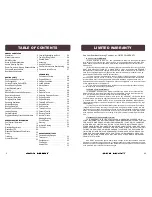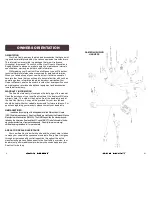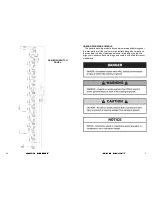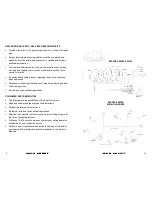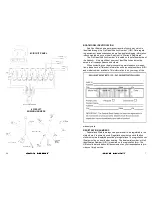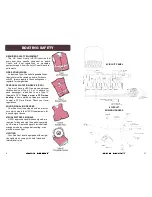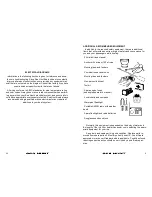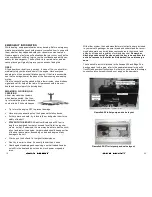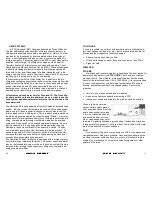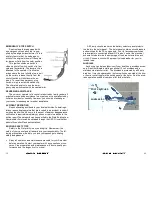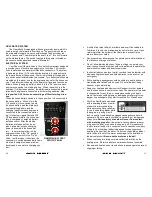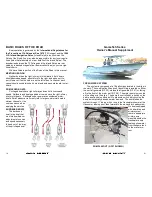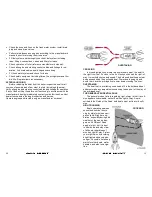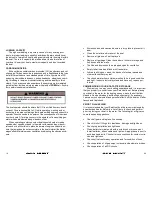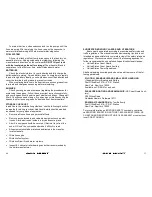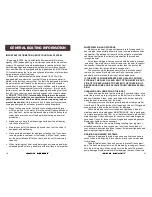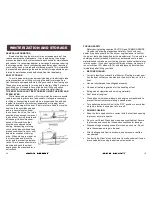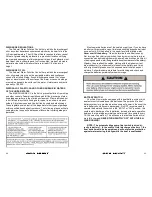
52
GRAYWATER SYSTEM
The Gamefish 29 is equipped with one graywater pump, which is
used to empty the forward in-floor fishbox. The pump is mounted on
the starboard stringer and is accessible though the door under the
sink in the console. The water exits the boat via a 1” thru hull forward
on the starboard side. The switch to activate this pump is located on
the console switch panel and labeled “Macerator”
ELECTRICAL SYSTEM
Your Sea Hunt Gamefish has a 12 volt electrical system designed
to provide years of trouble free enjoyment of your boat. All connec-
tions in wet areas use waterproof Deutsch
®
connectors. The system
is powered by three (3) 12 volt batteries located in a compartment in
the lower aft area of the console. Power is distributed through a bat-
tery switch panel located inside the console. Two battery switches are
mounted on this panel, one for the engines and one for the house ser-
vice. The battery switches are of the dual circuit type and function as
follows: When the engine battery switch is in the “On” position, each
engine is connected to a starting battery. When the switch is in the
combine (1+2) batteries position, the batteries are connected in paral-
lel and both engines are connected to both starting batteries.
Use
this position ONLY when encountering a difficult starting situa-
tion.
When the house battery switch is in the on position, it is connected to
the house battery. When it is in the
1+2 position, it is connected to both
the house battery and the starboard
engine starting battery, and the
charging leads from each engine are
connected to their respective batter-
ies. (On factory–rigged Yamaha 250
HP and above motors, the house bat-
tery is charged by Yamaha’s battery
isolation circuit.) After the starting
batteries are topped off by the en-
gine’s alternator, excess charging
power is directed to the house bat-
tery. In normal operation, run the
engine switches in the “On” position
and the house switch in the “On” po-
sition. In either case, it should not be
necessary to switch between batteries to
maintain a charge (unless a problem
developed in one motor’s charging sys-
tem).
GAMEFISH BATTERY
SWITCH PANEL
13
A written float plan left with a reliable person will be valuable in-
formation if you have a mishap and do not return on time. Upon
returning inform the holder of the float plan to prevent false
alarms about your safety.
Never operate or allow anyone to operate your boat while under
the influence of drugs or alcohol.
Do not allow individuals under 16 years of age to operate your
boat. Inexperienced drivers should not be allowed to operate the
boat without constant and direct supervision.
Instruct at least one person to pilot your boat and be familiar with
basic boating techniques and safe operation in the event of an
emergency.
While boating, passengers should be settled in a safe position.
Handholds and rails should be used. Do not allow bow-riding,
transom or gunwale riding.
Keep your boat speed under control. Respect for other boaters
and those on shore is common courtesy. The operator of the boat
is responsible for any injury or damage caused by the boat’s
wake. Your wake could swamp or damage a smaller craft or en-
danger its passengers. Stay alert for posted “No Wake Zones”.
Your Sea Hunt Boat is equipped
with a boarding ladder or swim
platform to aid in reboarding
while swimming. Never attempt
to use the boarding ladder while
the engine is running. A shift
lever in neutral could become engaged causing severe harm to
swimmers. Do not operate your boat in swimming or diving areas
at any time.
Serious injury or death will occur from contact
with a rotating propeller.
Use extreme caution whenever swim-
ming near the boat, even when the engine is off. A propeller will
tend to rotate if subject to a current and could cause serious injury
or death. Your boarding ladder is designed for use by persons
boarding the boat from the water. Do not use the boarding ladder
while the boat is out of the water, as damage to the boat and/or
ladder could result.
Never use the motor as a ladder!
When venturing into foreign waters collect information on the
boating area. Obtain charts for new areas whenever possible.
Recommend boat shoes or tennis shoes to passengers to prevent
slipping or falling.


